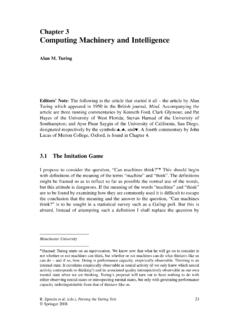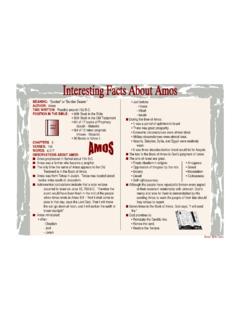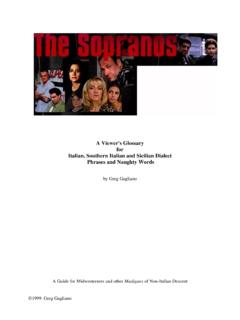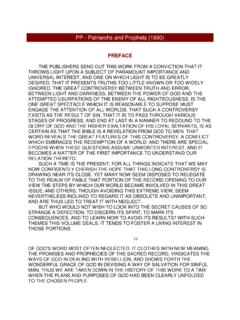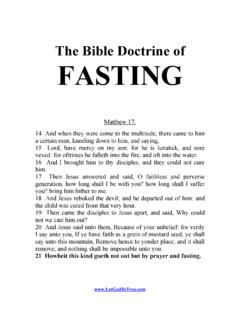Transcription of Fitness, Probability and the Principles of Natural …
1 Brit. J. Phil. Sci. 55 (2004), 693 712, axh406. fitness , Probability and the Principles of Natural selection Fre de ric Bouchard and Alex Rosenberg ABSTRACT. We argue that a fashionable interpretation of the theory of Natural selection as a claim exclusively about populations is mistaken. The interpretation rests on adopting an analysis of fitness as a probabilistic propensity which cannot be substantiated, draws parallels with thermodynamics which are without foundations, and fails to do justice to the fundamental distinction between drift and selection . This distinction requires a notion of fitness as a pairwise comparison between individuals taken two at a time, and so vitiates the interpretation of the theory as one about populations exclusively. Introduction There is a strong temptation to treat the theory of Natural selection solely as a claim about the central tendencies' in evolution. In the words of Sterelny and Kitcher ([1988], p. 345): evolutionary theory, like statistical mechanics, has no use for such a fine grain of description [as the biography of each organism]: the aim is to make clear the central tendencies in the history of evolving popula- tions.
2 ' Not only does such an interpretation seem to do justice to the centrality of population genetics a thoroughly statistical enterprise to evolutionary biology, but it also bids fair to solve or dissolve the long-standing problem of explaining or explaining away fitness ', and to account for the theory's char- acter in terms familiar from physics. In this paper we show why the temptation must be resisted. We argue that these benefits are not obtained, and that, moreover, the approach obscures crucial facts about the theory of Natural selection . In Section 1 we show that the probabilistic propensity account of fitness required by the central tendencies' approach is no substitute for the causal conception of comparative fitness as a pairwise relation between individual organisms. In Section 2 we refute recent attempts to purge the theory of a causal concept of fitness by interpreting the theory, along the lines of the second law of thermodynamics, as one exclusively about ensembles'. # British Society for the Philosophy of Science 2004.
3 694 Fre de ric Bouchard and Alex Rosenberg In Section 3 we apply these results to an analysis of the nature of evolutionary drift, which both demonstrates the evolutionary indispensability of the causal concept of fitness and identifies the real source of evolutionary probabilities. 1 Problems of probabilistic fitness 2 The PNS and the second law of thermodynamics 3 Drift and selection 4 Conclusion 1 Problems of probabilistic fitness It is convenient to express the central tendency' approach in terms of a contrast between two Principles of Natural One version quantifies over populations: PNSpop (x) (y) (E) [If x and y are competing populations and x is fitter than y in E at generation n, then probably (x's size is larger than y in E at some generation n' later than n)]. The PNSpop is relativized to environments E, since fitness is relative to an We cannot narrow down the later generation beyond some'. generation or other, for reasons that will be made clear below. The central tendencies' interpretation of the theory of Natural selection is the claim that the PNSpop need not be further grounded on claims about the fitness of Biologists and philosophers who reject the temptation to stop with this principle may wish to endorse something like the following principle of Natural selection for individuals: 1.
4 Cf. Brandon ([1978], [1990]) for discussion of these formulations of the Principle of Natural selection , hereafter PNS. 2. Some recent advocates of the central tendencies' approach substitute one of the PNS's deductive consequences for the PNS itself. Instead of the PNS, Matthen and Ariew ([2002], p. 73) treat Fisher's fundamental theorem of Natural selection as the central explanatory principle of Darwinism. This theorem states that the fitness of a population increases at a rate proportional to the genetic variance in fitness present in the population (cf. Strickberger [1985], p. 728). Matthen and Ariew's version of the theorem, is attributed to C .C. Li: In a subdivided population the rate of change in [overall population] growth rate [ fitness ] is proportional to the variance in growth rates [ fitnesses].' Variance', of course, is a population-level property, and so suits Fisher's theorem to express the central tendency thesis that Matthen and Ariew defend. However, the claims to be made here about the PNSpop could equally well be made with respect to Fisher's theorem.
5 3. Cf. also Walsh, Lewens and Ariew ([2002], p. 460): The objective of Natural selection is to explain and predict changes in the relative frequencies of heritable traits within a population. The change that selection explains is a consequence of variation in fitness (citing Lewontin [1970, 1974], Brandon [1990]).' And further, Walsh, Lewens and Ariew ([2002], p. 469): Natural selection theory explains changes in the structure of a population, but not by appeal to the individual-level causes of births, deaths, and reproductions.'. fitness , Probability and the Principles of Natural selection 695. PNSind (x)(y)(E) [x and y are competing organisms in generation n, and x is fitter than y in E, then probably (there is some generation n', at which x has more descendants than y)]. These biologists and philosophers hold that, when PNSpop obtains, the PNSind is the most important part of the explanation as to why it Both Principles employ the relational property x is fitter than y' in their antecedents and the sentential operator probably (p)' in their consequents.
6 What these terms mean remain two of the most vexed questions of the philosophy of biology. On the answers to them turn the status of the theory of Natural selection as empirical science, and its connection to every other compartment of biology. Here are two proposed answers to the question of what fitness ' in the antecedent and probably' in the consequent of the PNSpop (and the PNSind if there is one) mean that are popular among philosophers of biology: x is fitter than y in E iff x has a probabilistic propensity to leave more offspring in E greater than y's probabilistic propensity to leave more offspring in Probably( )' The long-run relative frequency of ( ) approaches 1'. If we plug these two proposals into either or both the PNSpop and PNSind, at least three questions arise. First and perhaps most obvious is the question of how the consequents of either PNSpop or PNSind are related to the finite actual sequences if they are claims about the relative frequency in the long run, about infinite sequences.
7 The problems here are well We need a way of applying 4. As Sober ([2002]) points out, fitness has two quite different roles in evolutionary theory: [ fitness ]. describes the relationship of an organism to its environment. It also has a mathematical representation that allows predictions and explanations to be formulated' (p. 309). The PNSpop employs the mathematical representation'. The PNSind employs the organism/. environment relation which, it is worth noting, is closer to the way Darwin originally framed the theory. 5. The loci classici of this definition are Brandon ([1978]), and Beatty and Mills ([1979]). See also Brandon ([1990], chapter 1), and Sober ([1993] and [2000], both p. 71). The propensity to leave more offspring than one's competitor can also be understood as the summation of the propensities to leave specific numbers of offspring: if a has a propensity to leave 1 offspring higher than b's propensity to leave 1, and if a has a higher propensity to leave 2 offspring than b's propensity to leave 2 offspring, then we may summarize by saying that a has a higher propensity to leave more offspring than b's propensity to leave more offspring.
8 It should be noted that such a propensity doesn't have to focus on offspring numbers. Sober defines the comparative fitness of traits, not individuals or populations, stating Trait X is fitter than trait Y if and only if X has a higher Probability of survival and/or reproductive success than Y' ([2000], p. 71). Traits are types, abstract properties. Their survival and/or expected reproductive success is a matter either of the tropes that instantiate them or of the individuals or populations which manifest these tropes and through them the traits. Trait fitness differences require individual or population fitness differences. Other propensity accounts have also focused on persistence of a type instead of offspring numbers exclusively (see for instance Thoday [1953]). In this paper, we use propensity accounts' as shorthand for propensity accounts focusing on offspring contribution. 6. For a general introduction to these problems, see W. Salmon ([1966], pp. 83 95). 696 Fre de ric Bouchard and Alex Rosenberg a claim about infinite sequences to the actual finite sequences which the PNSs are to explain.
9 Although no non-controversial solution to this problem is available, there must be one. That the Probability in the consequent is a propensity has already, so to speak, been spoken for. It is the interpretation of Probability which almost invariably figures in the fitness -relations reported in antecedents of the PNSpop and PNSind. If we adopt the same meaning for the Probability in the consequent, then when the appropriate grammatical changes are made to accommodate this interpretation by attributing pro- babilistic dispositions to x and y, the two PNSs will turn out to be tautologies. The second issue is closely related. For either version of the PNS to be a contingent truth there must be some factual difference between the two probabilities: x has a probabilistic propensity to leave more offspring than y greater than y's probabilistic propensity to leave more offspring than x in every generation after n and the long-run relative frequency of (x's leaving more offspring than y). approaches 1.
10 If there is no factual difference between these two probabilities, both versions of the PNS become tautologies. Another way to put the point is that, in the two PNSs, the antecedent is supposed to identify a cause and the consequent an effect. Accordingly there must be, at least in principle, a difference between them in conceptual if not empirical content. What would show that there is a difference between these two kinds of probabilities? There certainly are philosophers of science who deny that an empirical distinction between probabilistic propensities and long-run relative frequen- cies is in general possible (see Earman [1986], pp. 147 51). Putting aside empiricist strictures, would it suffice to claim that, here as in quantum mechanics, we find a brute unanalyzable probabilistic dispositional property of a particular item, which generates long-run relative frequencies? Among philosophers of quantum mechanics, some hold that probabilistic propensities can explain actual frequencies (cf.)
